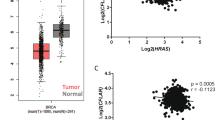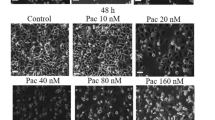Abstract
Disruption of interactions between epithelial cells and extracellular matrix proteins leads to apoptosis of the cells, a phenomenon termed anoikis. Anoikis seems to play important roles in control of cellular positioning and inhibition of inappropriate cell growth. Here we found that a protein kinase C (PKC) activator phorbol ester 12-O-tetradecanoyl phorbol-13-acetate (TPA) promoted cell death in human gastric cancer cell lines MKN45 and MKN74 only when they lost anchorage. Loss of anchorage slightly increased enzymatic activity of PKCα, and an addition of TPA promoted cell death with further increase of PKCα activity, but not PKCβ in MKN45 cells, implicating an involvement of PKCα in anoikis. Furthermore, vaccinia virus-mediated overexpression of PKCα strongly increased CPP32 activity in the detached MKN45 and MKN74 cells, and augmented anoikis, however it had little effect on viability and CPP32 activity in the attached cells. Taken together, PKCα promotes apoptotic cell death in gastric cancer cells depending upon loss of anchorage, thereby may be a modulator of anoikis.
This is a preview of subscription content, access via your institution
Access options
Subscribe to this journal
Receive 50 print issues and online access
$259.00 per year
only $5.18 per issue
Buy this article
- Purchase on Springer Link
- Instant access to full article PDF
Prices may be subject to local taxes which are calculated during checkout






Similar content being viewed by others
References
Abraham C, Scaglione-Sewell B, Skarosi SF, Qin W, Bissonnette M and Brasitus TA. . 1998 Gastroenterology 114: 503–509.
Asao T, Yazawa S, Kubo S, Takenoshita S and Nagamachi Y. . 1994 Cancer Lett. 78: 57–62.
Boudreau N, Sympson CJ, Werb Z and Bissell MJ. . 1995 Science 267: 891–893.
Chakrabarti S, Brechling K and Moss B. . 1985 Mol. Cell Biol. 5: 3403–3409.
Chen Q, Kinch MS, Lin TH, Burridge K and Juliano RL. . 1994 J. Biol. Chem. 269: 26602–26605.
Clemens MJ, Trayner I and Menaya J. . 1992 J. Cell Sci. 103: 881–887.
Cobb BS, Schaller MD, Leu TH, Burridge K and Juliano RL. . 1994 Mol. Cell Biol. 14: 147–155.
Dekker LV and Parker PJ. . 1994 Trends Biochem. Sci. 19: 73–77.
Derijard B, Hibi M, Wu I, Barrett T, Su B, Deng T, Karin M and David R. . 1994 Cell 76: 1025–1037.
Eichholtz T, de Bont DBA, de Widt J, Liskamp RMJ and Ploegh HL. . 1993 J. Biol. Chem. 268: 1982–1986.
Folkman J and Moscona A. . 1978 Nature 273: 345–249.
Frisch SM and Francis H. . (1994). J Cell Biol. 124: 619–626.
Frisch SM, Vuori K, Ruoslahti E and Chan-Hui PY. . 1996a J. Cell Biol. 134: 793–799.
Frisch SM, Vuori K, Kelaita D and Sicks S. . 1996b J. Cell Biol. 135: 1377–1382.
Guadägno TM, Ohtsubo M, Roberts JM and Assoian RK. . 1993 Science 262: 1572–1575.
House C, Werrenhall RE and Kemp BE. . 1987 J. Biol. Chem. 262: 772–777.
Hug H and Saue T. . 1993 Biochem. J. 291: 329–343.
Juliano RL and Varner JA. . 1993 Curr. Opin. Cell Biol. 5: 812–818.
Khwaja A and Downward J. . 1997 J. Cell Biol. 139: 1017–1023.
Kornberg L, Earp H, Turner C, Prockop C and Juliano R. . 1991 Proc. Natl. Acad. Sci. USA 88: 8392–8396.
Martiny-Baron G, Kazanietz MG, Mischak H, Blumberg PM, Kochs G, Hug H, Marmé D and Schächtele C. . 1993 J. Biol. Chem. 268: 9194–9197.
Meredith JE, Fazeli B and Schwartz MA. . 1993 Mol. Cell. Biol. 123: 485–496.
Nicholson DW, Ali A, Thornberry NA, Vaillancourt JP, Ding CK, Gallant M, Gareau Y, Griffin PR, Labelle M, Lazebnik YA, Munday NA, Raju SM, Smulson ME, Yamin T-T, Yu VL and Miller DK. . 1995 Nature (Lond.) 376: 37–43.
Nishizuka Y. . 1988 Nature 344: 661–665.
Scaglione-Sewell B, Abraham C, Bissonnette M, Skarosi SF, Hart J, Davidson NO, Wali RK, Sitrin M and Brasitus TA. . 1998 Cancer Res. 58: 1074–1081.
Schwartz MA. . 1993 Cancer Res. 53: 1503–1506.
Smith GL, Murphy BR and Moss B. . 1983 Proc. Natl. Acad. Sci. USA 80: 7155–7159.
Takaoka A, Adachi M, Okuda H, Sato S, Yawata A, Hinoda Y, Takayama S, Reed JC and Imai K. . 1997 Oncogene 14: 2971–2977.
Verstovsek G, Byrd A, Frey MR, Petrelli NJ and Black JD. . 1998 Gastroenterology 115: 75–85.
Ways DK, Cook PP, Webster C and Parker PJ. . 1992 J. Biol. Chem. 267: 4799–4805.
Yawata A, Adachi M, Okuda H, Naishiro Y, Takamura T, Hareyama M, Takayama S, Reed JC and Imai K. . 1988 Oncogene 16: 2681–2686.
Zhang Z, Vuori K, Reed JC and Ruoslahti E. . 1995 Proc. Natl. Acad. Sci. USA 92: 6161–6165.
Acknowledgements
We thank Dr Yoshitaka Ono (Department of Biology, Faculty of Science, Kobe University) for providing PKCα cDNA. This work is supported by Grants-in-Aid for Scientific Research on Priority Area Cancer from the Ministry of Health and Welfare (K Imai and M Adachi), Japan.
Author information
Authors and Affiliations
Rights and permissions
About this article
Cite this article
Okuda, H., Adachi, M., Miyazawa, M. et al. Protein kinase Cα promotes apoptotic cell death in gastric cancer cells depending upon loss of anchorage. Oncogene 18, 5604–5609 (1999). https://doi.org/10.1038/sj.onc.1202946
Received:
Revised:
Accepted:
Published:
Issue Date:
DOI: https://doi.org/10.1038/sj.onc.1202946



